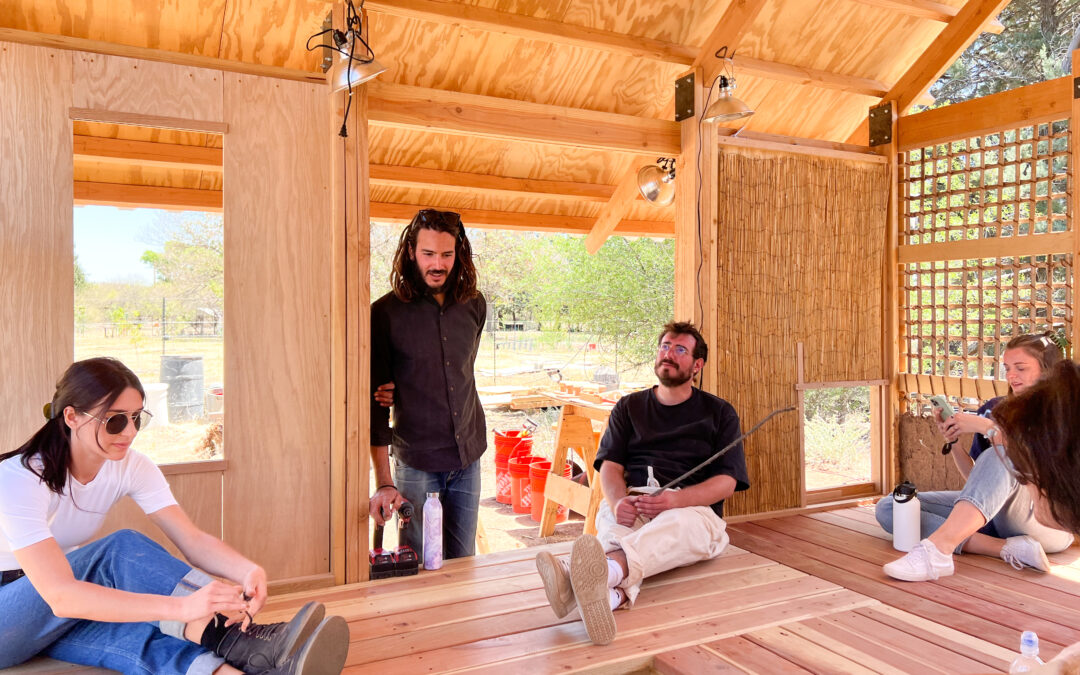Gimme Shelter
At Arcosanti, The School of Architecture unveils three new student projects.
By Nora Burba Trulsson
Photography courtesy of The School of Architecture
Just below the mesa populated with Arcosanti’s other-worldly buildings, three new structures have sprung up from the high desert floor. They’re not a continuation of the earth-cast apses and circle-and-cube architecture prevalent at the experimental architectural community founded in 1970 by Italian architect and theorist Paolo Soleri. Instead, the three structures are the work of Archie Kinney, William Palmer and Richard Sanchez as thesis projects for their master’s degrees from The School of Architecture (TSOA), which has been located at Arcosanti for a little more than two years.
Both TSOA and its shelter program have roots in Frank Lloyd Wright’s apprentice program, founded in 1932. Wright encouraged hands-on learning, and the apprentices—who were part of what was called the Taliesin Fellowship—built individual shelters over the decades in the desert at Taliesin West in Scottsdale. Soleri, too, was an apprentice under Wright in the later 1940s. The Taliesin shelters were meant to serve as micro responses to site, climate and programming needs. The apprentice/Fellowship program was later formalized and accredited as the Frank Lloyd Wright School of Architecture and, more recently, as The School of Architecture at Taliesin. The school split with the Frank Lloyd Wright Foundation, and, in the summer of 2020, decamped to Arcosanti, taking on its current name. Now led by Dean Stephanie Lin and President Chris Lasch, the school continues the Wrightian tradition of real-life projects and learning by doing, as exemplified by the shelter program.
These three shelters, built under the supervision of faculty members Matthew Trzebiatowski and Lloyd Natof, were imagined for a broad range of uses, with varied materials and degrees of permanence. Kinney’s “Octahedron” was designed as a viewing deck for the high desert landscape and includes various platforms that can accommodate a mattress or hammock. The octahedral timber structure incorporates nods to Arcosanti’s history, including rocks in the gabion walls. Sanchez’s “Earth Shed,” meant to be both a community gathering space and a place to store vegetables harvested from an adjacent field, features light timber framing and earthen walls, plastered with clay gathered from the bed of the nearby Agua Fria River. Palmer’s “Vergence” is a public pavilion, made of about 1,500 feet of jute rope formed into a tensile shading structure that hovers over a floating wooden deck.
“Our shelter program is one of the most unique in the country,” reflects Sanchez, who graduated in 2022. “It’s a proving ground for your ideas that tests you physically, mentally, emotionally and intellectually. Ideas are revealed through the process which I don’t think otherwise would happen if you simply did a regular thesis.”
New shelters from upcoming graduates are also in the works. Current student Tristan Durham will be breaking ground on his shelter this spring. “The shelter program teaches you to both dream big and realize the impact of your ideas on the people who will interact with your project on a daily basis—and beyond your graduation. It is both an opportunity and a responsibility that you earn.”

